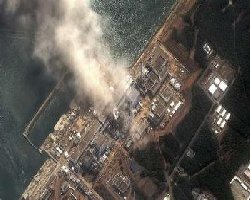The gung-ho nuclear industry is in deep shock. Just as it and its cheerleader, the International Atomic Energy Agency, were preparing to mark next month's 25th anniversary of the Chernobyl accident with a series of self-congratulatory statements about the dawning of a safe age of clean atomic power, a series of catastrophic but entirely avoidable accidents take place in not one but three reactors in one of the richest countries of the world. Fukushima is not a rotting old power plant in a failed state manned by half-trained kids, but supposedly one of the safest stations in one of the most safety-conscious countries with the best engineers and technologists in the world.
Chernobyl blew up not because the reactor malfunctioned but because an ill-judged experiment to see how long safety equipment would function during shutdown went too far. So, too, in Japan, it was not the nuclear bits of the station that went wrong but the conventional technology. The pumps did not work because the power supply went down and the back-up support was not there because no one had thought what happened was possible.
Even though Japan had been warned many times that possibly the most dangerous place in the world to site a nuclear power station was on its coast, no one had taken into account the double-whammy effect of a tsunami and an earthquake on conventional technology. It's easy to be wise after the event, but the inquest will surely show that the accident was not caused by an unpredictable natural disaster, but by a series of highly predictable bad calls by human regulators.
The question now is whether the industry can be trusted anywhere. If this industry were a company, its shareholders would have deserted it years ago. In just one generation it has killed, wounded or blighted the lives of many millions of people and laid waste to millions of square miles of land. In that time it has been subsidized to the tune of trillions of dollars and it will cost hundreds of billions more to clean up and store the messes it has caused and the waste it has created. It has had three catastrophic failures now in 25 years and dozens more close shaves. Its workings have been marked around the world by mendacity, cover-ups, secrecy and financial incompetence.
Sadly, the future looks worse. The world has a generation of reactors coming to the end of their days and politicians putting intense pressure on regulators to extend their use well beyond their design lives. We are planning to double worldwide electricity supply from nuclear power in the next 20 years, but we have nowhere near enough experienced engineers to run the ever-bigger stations. We have private companies peddling new designs that are said to be safer but which are still not proven, and we have 10 new countries planning to move into civil nuclear power in the next five years.
It gets worse. More than 100 of the world's reactors are already sited in areas of high seismic activity and many of 350 new stations planned for the highly volatile Pacific rim where earthquakes, tsunamis and other natural hazards are certain to happen. We still have not worked out how to store waste and, we now know that we cannot protect stations from all eventualities.
Next time the disaster may have nothing to do with an earthquake or a tsunami, but be because of climate change, terrorism, a fatal error in an anonymous engineering works, proliferation of plutonium or a deranged plant manager. If there were no alternatives than employing nuclear power to light up a bulb or to reduce carbon emissions then the industry and governments might be forgiven. But when the stakes are so high, the scale is so big and there are 100 other safer ways, it seems sheer folly to go on in this way.
PHOTO CAPTION
The No.3 nuclear reactor of the Fukushima Daiichi nuclear plant is seen burning after a blast following an earthquake and tsunami in this handout satellite image taken March 14, 2011.
Source: Guardian.co.uk


 Home
Home Discover Islam
Discover Islam Quran Recitations
Quran Recitations Lectures
Lectures
 Fatwa
Fatwa Articles
Articles Fiqh
Fiqh E-Books
E-Books Boys & Girls
Boys & Girls  Articles
Articles










